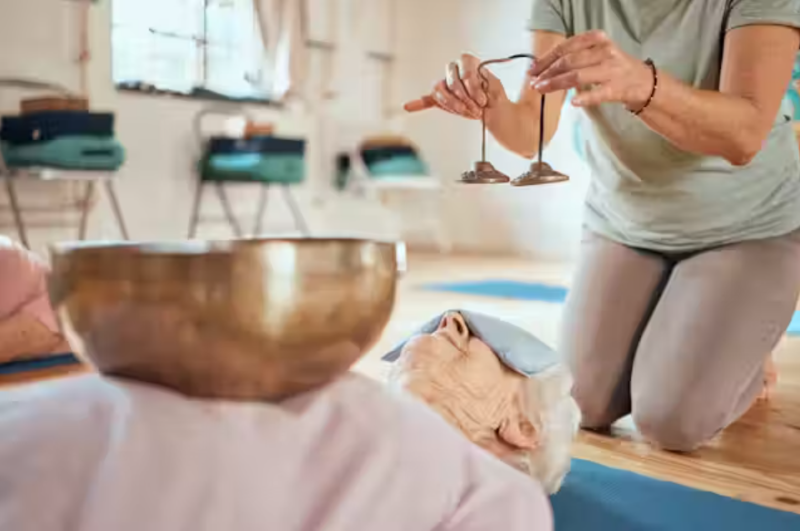
A deeper underlying mechanism of the beneficial effects associated with meditation.

By Dr. Hari Sharma
Physician, Ayurveda Practitioner
Center for Integrative Medicine
Department of Family Medicine
College of Medicine
The Ohio State University, Columbus
Abstract
Meditation has become popular in many Western nations, especially the USA. An increasing body of research shows various health benefits associated with meditation and these findings have sparked interest in the field of medicine. The practice of meditation originated in the ancient Vedic times of India and is described in the ancient Vedic texts. Meditation is one of the modalities used in Ayurveda (Science of Life), the comprehensive, natural health care system that originated in the ancient Vedic times of India. The term “meditation” is now loosely used to refer to a large number of diverse techniques. According to Vedic science, the true purpose of meditation is to connect oneself to one’s deep inner Self. Techniques which achieve that goal serve the true purpose of meditation. Neurological and physiological correlates of meditation have been investigated previously. This article describes the process of meditation at a more fundamental level and aims to shed light on the deeper underlying mechanism of the beneficial effects associated with meditation. Research on the effects of meditation is summarized.
Introduction
The practice of meditation has become popular in many Western nations, especially the USA. An ever-increasing body of research shows various health benefits associated with meditation and these findings have sparked interest in the field of medicine.[1,2,3] The practice of meditation originated in the ancient Vedic times of India and is described in the Vedic texts.[4,5,6,7] Meditation is one of the modalities used in Ayurveda (Science of Life), the comprehensive, natural health care system that originated in the ancient Vedic times of India.[8] The term “meditation” is now loosely used to refer to a large number of diverse techniques. These include contemplation, concentration, use of nature sounds such as the ocean, guided meditation, meditative movement exercises such as Yoga and tai chi, qigong, breathing exercises, and Mantra. These techniques work at different levels such as the senses, mind, intellect, and emotions. Some techniques are easy to learn and practice, while others are more difficult and can result in participants giving up the practice rather quickly. According to Vedic science (the knowledge of the Vedic texts of ancient India), the true purpose of meditation is to connect oneself to one’s deep inner Self. Techniques which achieve that goal serve the true purpose of meditation.
The neurological and physiological correlates of meditative experiences have been investigated previously.[8,9,10,11,12,13,14,15,16] This article describes the process of meditation at a more fundamental level and aims to shed light on the deeper underlying mechanism of the beneficial effects associated with meditation. Research on the effects of meditation is summarized.
The Process of Meditation

To truly understand meditation, one has to understand how the human being is viewed by Vedic science – the knowledge of the Vedic texts of ancient India.[4,5,6,7] The human being consists of three aspects, with their associated functions:
- Physical body
- Inner faculty: The working consciousness, which is constantly changing. This consists of:
- Mind: Processes sensory perceptions; has the quality of duality, as seen in pairs of opposites, for example, pleasure and pain, good and bad, hot and cold, etc.
- Intellect: Analyzes, discriminates, decides, and judges
- Ego: Doer and experiencer
- Chitta: The storehouse of all memories and impressions of life
- Deep inner Self: The nonchanging pure consciousness, which has the quality of unity and witnesses the activity of the inner faculty. The deep inner Self is the source of all knowledge, intelligence, creativity, and all natural laws that govern existence.
According to Vedic science, the deep inner Self activates the inner faculty (working consciousness), which in turn activates the physical body. A feedback loop is provided by meditation, in which a conscious connection is made with the deep inner Self. This view of the human being correlates with the scientific view of deoxyribonucleic acid (DNA) in the body. On the cellular level, DNA creates and controls all activities in the body. Information from the DNA proceeds to ribonucleic acid (RNA), then to the amino acids, through which proteins are formed. A feedback loop to the DNA starts a new cycle to provide whatever is needed for the activities of the cell. In meditation, the feedback loop to the deep inner Self (the seat of knowledge, like DNA) provides inner peace and bliss, which removes the accumulated stresses of life and improves overall health.
Human beings routinely experience three states of consciousness:
- Waking
- Dreaming
- Deep sleep.
When the inner faculty is in the waking state of consciousness, it is aware of the physical body and is involved with the outside objective world. In the dreaming state of consciousness, it is aware of the inner dream world, but is not aware of the physical body. In the deep sleep state of consciousness, the inner faculty is not functioning at all and is not aware of anything. In this state, dualities such as pleasure and pain, good and bad, etc., are not experienced. There is no experience of stress, anxiety, guilt, greed, envy, jealousy, anger, etc. The only experience in this state of unity is peace and bliss. This is why deep sleep or a “good night’s sleep” feels so good.
The deep inner Self is always witnessing, or watching, the activity of the inner faculty. The experience of watching one’s thoughts or daydreams occurs when the deep inner Self witnesses the activity of the waking state. During the dreaming state, this is experienced as watching one’s dreams. During the deep sleep state, however, the inner faculty is asleep and not functioning on the level of duality. This is experienced as the peace and bliss of unity, and upon waking one feels refreshed from a good night’s sleep.
There are various forms of meditation. The meditation process described herein attains the goal of meditation described in the ancient Vedic texts. This meditation process takes the mind from the outer realm of the objective world to the inner realm of the inner faculty (which includes the mind, intellect, ego, and Chitta – the storehouse of all memories and impressions of life), and finally goes beyond both the outer and inner realms to reach the deep inner Self. This deep inner Self is nonchanging pure consciousness, which witnesses the activity of the inner faculty. The inner faculty is the working consciousness, which is constantly changing. Going beyond the changing inner faculty to the nonchanging pure consciousness provides inner peace and bliss, which removes the accumulated stresses of life. This results in energizing the body and improving overall health.[7]
In deep sleep, the unity of the deep inner Self is experienced. In the process of meditation, one experiences the unity of the deep inner Self while aware and not sleeping. This experience of the peace and bliss of unity modifies the inner faculty. The properties of the deep inner Self begin to extend into the inner faculty, and since the deep inner Self is the source of all knowledge (which correlates with DNA on the physical level), the benefits of this process extend to all aspects of life – physical, mental, emotional, spiritual, etc.
Effects of Meditation

During the process of meditation, accumulated stresses are removed, energy is increased, and health is positively affected overall.[7] Research has confirmed a myriad of health benefits associated with the practice of meditation. These include stress reduction,[1,2,17,18,19,20] decreased anxiety,[1,17,19,21,22] decreased depression,[1,17,18,23,24] reduction in pain (both physical and psychological),[2,25,26] improved memory,[2,27] and increased efficiency.[12,28,29,30] Physiological benefits include reduced blood pressure,[2,31,32,33] heart rate,[2,16] lactate,[15,34] cortisol,[35,36,37] and epinephrine;[38] decreased metabolism,[15] breathing pattern,[39,40] oxygen utilization, and carbon dioxide elimination;[15,41] and increased melatonin,[42,43] dehydroepiandrosterone sulfate (DHEA-S),[44,45] skin resistance,[15,16] and relative blood flow to the brain. Meditation increases regional cerebral blood flow in the frontal and anterior cingulate regions of the brain,[46,47,48,49,50] increases efficiency in the brain’s executive attentional network,[12,28,29,30] and increases electroencephalogram (EEG) coherence.[13,14] A study on the effect of meditation on the executive attentional network found that meditators were faster on all tasks.[12] With aging, the brain cortical thickness (gray matter, which contains neurons) decreases, whereas meditation experience is associated with an increase in gray matter in the brain.[11,26,51,52]
Meditation decreases sympathetic overstimulation[53,54] and reduces cholesterol[55,56,57] and smoking.[58,59,60] A study investigating the effects of meditation on exercise-induced myocardial ischemia in patients with coronary artery disease found that meditation significantly increased exercise tolerance and maximal workload, and delayed the onset of ST-segment depression.[61] In a randomized, controlled trial of 201 African-American men and women with coronary heart disease, the effects of meditation versus health education were investigated. After 5 years, there was a 48% risk reduction in deaths, heart attacks, and strokes in the meditation group. There was also a significant drop in blood pressure and significant reduction in psychosocial stress factors.[19] Efficacy of meditation techniques has been found for epilepsy, symptoms of premenstrual syndrome, and menopausal symptoms.[1] Benefits have been demonstrated for mood and anxiety disorders,[1,17,21,22] autoimmune illness,[1,54] and emotional disturbances in neoplastic disease.[1,62]
Research has shown that a program of comprehensive lifestyle changes (including vegetarian diet and stress management – meditation and breathing exercises) improved health and modulated gene expression in prostate cancer patients who were not treated with surgery, radiation, or hormone therapy. This 3-month study showed changes in more than 500 genes: 48 genes were up-regulated and 453 genes were down-regulated. The down-regulated genes included disease-promoting genes with critical roles in tumorigenesis.[63] There are distinct gene expression changes induced not only by physical influences, but also by psychological, social, and cultural factors, as identified by the emerging field of psychosocial genomics.[64] Meditation and Yoga practices positively affect gene expression.[65,66]
Telomerase is the enzyme responsible for protecting and maintaining the length of telomeres, the protective caps at the end of chromosomes that promote chromosomal stability. Shorter telomeres are associated with accelerated aging and related diseases. Chronic stress reduces telomerase activity and accelerates telomere shortening and premature aging.[67,68,69] Meditation and Yoga practices improve telomerase activity and telomere length.[70,71] A study investigating the effect of meditation on the aging process showed that long-term meditators have a significantly younger biological age compared to short-term meditators and controls.[72] Meditation has resulted in a significant reduction in payments to physicians by a government health insurance agency. Over a period of 5 years, there was a cumulative reduction of 28% in high-cost meditators compared to high-cost nonmeditators.[73]
Conclusion
Meditation, as described in the ancient Vedic texts, is an exercise of consciousness that results in the expansion of consciousness beyond the day-to-day experience of duality. It is an experience of unity, which reduces stress and brings increased creativity and efficiency to the functioning of the inner faculty. This is an exercise that occurs without the mind directing the process. In physical exercise, the mind does not tell the muscles to get stronger; rather, the muscles are strengthened automatically by the exercise process. Likewise, in this exercise of consciousness, that is, meditation, the results are achieved automatically, not by controlling the mind or any other mental manipulation. The process of meditation goes beyond the mind to the deepest level of the inner Self.
Endnotes
1. Arias AJ, Steinberg K, Banga A, Trestman RL. Systematic review of the efficacy of meditation techniques as treatments for medical illness. J Altern Complement Med. 2006;12:817–32. [PubMed] [Google Scholar]
2. Horowitz S. Health benefits of meditation. Altern Complement Ther. 2010;16:223–8. [Google Scholar]
3. Fortney L, Taylor M. Meditation in medical practice: A review of the evidence and practice. Prim Care. 2010;37:81–90. [PubMed] [Google Scholar]
4. Aurobindo S. Pondicherry, India: Sri Aurobindo Ashram; 1972. The Upanishads: Texts, Translations and Commentaries. [Google Scholar]
5. Gambhirananda S. Calcutta, India: Advaita Ashrama; 1972. Translator. Brahma-Sutra-Bhasya of Sri Sankaracharya. [Google Scholar]
6. Wadhwa A, Wadhwa D. Haridwar, India: Akhand Param Dham; 2013. The Direct Realization of Brahman: Brahman Sakshatkar. [Google Scholar]
7. Saraswati SM. Munger, India: Bihar School of Yoga; 1993. Commentator. Hatha Yoga Pradipika. [Google Scholar]
8. Sharma H, Clark C. London: Singing Dragon; 2012. Ayurvedic Healing. [Google Scholar]
9. Newberg AB, Iversen J. The neural basis of the complex mental task of meditation: Neurotransmitter and neurochemical considerations. Med Hypotheses. 2003;61:282–91. [PubMed] [Google Scholar]
10. Lutz A, Greischar LL, Rawlings NB, Ricard M, Davidson RJ. Long-term meditators self-induce high-amplitude gamma synchrony during mental practice. Proc Natl Acad Sci U S A. 2004;101:16369–73. [PMC free article] [PubMed] [Google Scholar]
11. Lazar SW, Kerr CE, Wasserman RH, Gray JR, Greve DN, Treadway MT, et al. Meditation experience is associated with increased cortical thickness. Neuroreport. 2005;16:1893–7. [PMC free article] [PubMed] [Google Scholar]
12. Chan D, Woollacott M. Effects of level of meditation experience on attentional focus: Is the efficiency of executive or orientation networks improved? J Altern Complement Med. 2007;13:651–7. [PubMed] [Google Scholar]
13. Travis F, Arenander A. Cross-sectional and longitudinal study of effects of Transcendental Meditation practice on interhemispheric frontal asymmetry and frontal coherence. Int J Neurosci. 2006;116:1519–38. [PubMed] [Google Scholar]
14. Travis F, Tecce J, Arenander A, Wallace RK. Patterns of EEG coherence, power, and contingent negative variation characterize the integration of transcendental and waking states. Biol Psychol. 2002;61:293–319. [PubMed] [Google Scholar]
15. Jevning R, Wallace RK, Beidebach M. The physiology of meditation: A review. A wakeful hypometabolic integrated response. Neurosci Biobehav Rev. 1992;16:415–24. [PubMed] [Google Scholar]
16. Telles S, Raghavendra BR, Naveen KV, Manjunath NK, Kumar S, Subramanya P. Changes in autonomic variables following two meditative states described in yoga texts. J Altern Complement Med. 2013;19:35–42. [PMC free article] [PubMed] [Google Scholar]
17. Burns JL, Lee RM, Brown LJ. The effect of meditation on self-reported measures of stress, anxiety, depression, and perfectionism in a college population. J College Stud Psychother. 2011;25:132–44. [Google Scholar]
18. Elder C, Nidich S, Moriarty F, Nidich R. Effect of Transcendental Meditation on employee stress, depression, and burnout: A randomized controlled study. Perm J. 2014;18:19–23. [PMC free article] [PubMed] [Google Scholar]
19. Schneider RH, Grim CE, Rainforth MV, Kotchen T, Nidich SI, Gaylord-King C, et al. Stress reduction in the secondary prevention of cardiovascular disease: Randomized, controlled trial of Transcendental Meditation and health education in blacks. Circ Cardiovasc Qual Outcomes. 2012;5:750–8. [PMC free article] [PubMed] [Google Scholar]
20. Alexander CN, Swanson GC, Rainforth MV, Carlisle TW, Todd CC, Oates RM. Effects of the Transcendental Meditation program on stress reduction, health, and employee development: A prospective study in two occupational settings. Anxiety Stress Coping. 1993;6:245–62. [Google Scholar]
21. Orme-Johnson DW, Barnes VA. Effects of the Transcendental Meditation technique on trait anxiety: A meta-analysis of randomized controlled trials. J Altern Complement Med. 2014;20:330–41. [PubMed] [Google Scholar]
22. Chen KW, Berger CC, Manheimer E, Forde D, Magidson J, Dachman L, et al. Meditative therapies for reducing anxiety: A systematic review and meta-analysis of randomized controlled trials. Depress Anxiety. 2012;29:545–62. [PMC free article] [PubMed] [Google Scholar]
23. Lavretsky H, Epel ES, Siddarth P, Nazarian N, St Cyr N, Khalsa DS, et al. A pilot study of yogic meditation for family dementia caregivers with depressive symptoms: Effects on mental health, cognition, and telomerase activity. Int J Geriatr Psychiatry. 2013;28:57–65. [PMC free article] [PubMed] [Google Scholar]
24. Kasala ER, Bodduluru LN, Maneti Y, Thipparaboina R. Effect of meditation on neurophysiological changes in stress mediated depression. Complement Ther Clin Pract. 2014;20:74–80. [PubMed] [Google Scholar]
25. Orme-Johnson DW, Schneider RH, Son YD, Nidich S, Cho ZH. Neuroimaging of meditation’s effect on brain reactivity to pain. Neuroreport. 2006;17:1359–63. [PMC free article] [PubMed] [Google Scholar]
26. Grant JA, Courtemanche J, Duerden EG, Duncan GH, Rainville P. Cortical thickness and pain sensitivity in zen meditators. Emotion. 2010;10:43–53. [PubMed] [Google Scholar]
27. Khalsa DS. Stress, meditation, and Alzheimer’s disease prevention: Where the evidence stands. J Alzheimers Dis. 2015;48:1–12. [PMC free article] [PubMed] [Google Scholar]
28. Kozasa EH, Sato JR, Lacerda SS, Barreiros MA, Radvany J, Russell TA, et al. Meditation training increases brain efficiency in an attention task. Neuroimage. 2012;59:745–9. [PubMed] [Google Scholar]
29. Deepeshwar S, Vinchurkar SA, Visweswaraiah NK, Nagendra HR. Hemodynamic responses on prefrontal cortex related to meditation and attentional task. Front Syst Neurosci. 2015;8:252. doi: 10.3389/fnsys.2014.00252. [PMC free article] [PubMed] [Google Scholar]
30. Elliott JC, Wallace BA, Giesbrecht B. A week-long meditation retreat decouples behavioral measures of the alerting and executive attention networks. Front Hum Neurosci. 2014;8:69. doi: 10.3389/fnhum. 2014.00069. [PMC free article] [PubMed] [Google Scholar]
31. Brook RD, Appel LJ, Rubenfire M, Ogedegbe G, Bisognano JD, Elliott WJ, et al. Beyond medications and diet: Alternative approaches to lowering blood pressure: A scientific statement from the American Heart Association. Hypertension. 2013;61:1360–83. [PubMed] [Google Scholar]
32. Rainforth MV, Schneider RH, Nidich SI, Gaylord-King C, Salerno JW, Anderson JW. Stress reduction programs in patients with elevated blood pressure: A systematic review and meta-analysis. Curr Hypertens Rep. 2007;9:520–8. [PMC free article] [PubMed] [Google Scholar]
33. Nidich SI, Rainforth MV, Haaga DA, Hagelin J, Salerno JW, Travis F, et al. A randomized controlled trial on effects of the Transcendental Meditation program on blood pressure, psychological distress, and coping in young adults. Am J Hypertens. 2009;22:1326–31. [PMC free article] [PubMed] [Google Scholar]
34. Solberg EE, Ingjer F, Holen A, Sundgot-Borgen J, Nilsson S, Holme I. Stress reactivity to and recovery from a standardised exercise bout: A study of 31 runners practising relaxation techniques. Br J Sports Med. 2000;34:268–72. [PMC free article] [PubMed] [Google Scholar]
35. Ray IB, Menezes AR, Malur P, Hiltbold AE, Reilly JP, Lavie CJ. Meditation and coronary heart disease: A review of the current clinical evidence. Ochsner J. 2014;14:696–703. [PMC free article] [PubMed] [Google Scholar]
36. Lau WK, Leung MK, Chan CC, Wong SS, Lee TM. Can the neural-cortisol association be moderated by experience-induced changes in awareness? Sci Rep. 2015;5:16620. doi: 10.1038/srep16620. [PMC free article] [PubMed] [Google Scholar]
37. Jevning R, Wilson AF, Davidson JM. Adrenocortical activity during meditation. Horm Behav. 1978;10:54–60. [PubMed] [Google Scholar]
38. Infante JR, Torres-Avisbal M, Pinel P, Vallejo JA, Peran F, Gonzalez F, et al. Catecholamine levels in practitioners of the Transcendental Meditation technique. Physiol Behav. 2001;72:141–6. [PubMed] [Google Scholar]
39. Travis F. Transcendental experiences during meditation practice. Ann N Y Acad Sci. 2014;1307:1–8. [PubMed] [Google Scholar]
40. Wolkove N, Kreisman H, Darragh D, Cohen C, Frank H. Effect of Transcendental Meditation on breathing and respiratory control. J Appl Physiol Respir Environ Exerc Physiol. 1984;56:607–12. [PubMed] [Google Scholar]
41. Wilson AF, Jevning R, Guich S. Marked reduction of forearm carbon dioxide production during states of decreased metabolism. Physiol Behav. 1987;41:347–52. [PubMed] [Google Scholar]
42. Tooley GA, Armstrong SM, Norman TR, Sali A. Acute increases in night-time plasma melatonin levels following a period of meditation. Biol Psychol. 2000;53:69–78. [PubMed] [Google Scholar]
43. Harinath K, Malhotra AS, Pal K, Prasad R, Kumar R, Kain TC, et al. Effects of Hatha yoga and Omkar meditation on cardiorespiratory performance, psychologic profile, and melatonin secretion. J Altern Complement Med. 2004;10:261–8. [PubMed] [Google Scholar]
44. Glaser JL, Brind JL, Vogelman JH, Eisner MJ, Dillbeck MC, Wallace RK, et al. Elevated serum dehydroepiandrosterone sulfate levels in practitioners of the Transcendental Meditation (TM) and TM-Sidhi programs. J Behav Med. 1992;15:327–41. [PubMed] [Google Scholar]
45. Walton KG, Pugh ND, Gelderloos P, Macrae P. Stress reduction and preventing hypertension: Preliminary support for a psychoneuroendocrine mechanism. J Altern Complement Med. 1995;1:263–83. [PubMed] [Google Scholar]
46. Jevning R, Anand R, Biedebach M, Fernando G. Effects on regional cerebral blood flow of Transcendental Meditation. Physiol Behav. 1996;59:399–402. [PubMed] [Google Scholar]
47. Newberg A, Alavi A, Baime M, Pourdehnad M, Santanna J, d’Aquili E. The measurement of regional cerebral blood flow during the complex cognitive task of meditation: A preliminary SPECT study. Psychiatry Res. 2001;106:113–22. [PubMed] [Google Scholar]
48. Khalsa DS, Amen D, Hanks C, Money N, Newberg A. Cerebral blood flow changes during chanting meditation. Nucl Med Commun. 2009;30:956–61. [PubMed] [Google Scholar]
49. Newberg AB, Wintering N, Khalsa DS, Roggenkamp H, Waldman MR. Meditation effects on cognitive function and cerebral blood flow in subjects with memory loss: A preliminary study. J Alzheimers Dis. 2010;20:517–26. [PubMed] [Google Scholar]
50. Wang DJ, Rao H, Korczykowski M, Wintering N, Pluta J, Khalsa DS, et al. Cerebral blood flow changes associated with different meditation practices and perceived depth of meditation. Psychiatry Res. 2011;191:60–7. [PubMed] [Google Scholar]
51. Luders E, Toga AW, Lepore N, Gaser C. The underlying anatomical correlates of long-term meditation: Larger hippocampal and frontal volumes of gray matter. Neuroimage. 2009;45:672–8. [PMC free article] [PubMed] [Google Scholar]
52. Fox KC, Nijeboer S, Dixon ML, Floman JL, Ellamil M, Rumak SP, et al. Is meditation associated with altered brain structure?. A systematic review and meta-analysis of morphometric neuroimaging in meditation practitioners. Neurosci Biobehav Rev. 2014;43:48–73. [PubMed] [Google Scholar]
53. Mills PJ, Schneider RH, Hill D, Walton KG, Wallace RK. Beta-adrenergic receptor sensitivity in subjects practicing Transcendental Meditation. J Psychosom Res. 1990;34:29–33. [PubMed] [Google Scholar]
54. Bantornwan S, Watanapa WB, Hussarin P, Chatsiricharoenkul S, Larpparisuth N, Teerapornlertratt T, et al. Role of meditation in reducing sympathetic hyperactivity and improving quality of life in lupus nephritis patients with chronic kidney disease. J Med Assoc Thai. 2014;97(Suppl 3):S101–7. [PubMed] [Google Scholar]
55. Walton KG, Schneider RH, Nidich S. Review of controlled research on the Transcendental Meditation program and cardiovascular disease. Risk factors, morbidity, and mortality. Cardiol Rev. 2004;12:262–6. [PMC free article] [PubMed] [Google Scholar]
56. Vyas R, Raval KV, Dikshit N. Effect of Raja yoga meditation on the lipid profile of post-menopausal women. Indian J Physiol Pharmacol. 2008;52:420–4. [PubMed] [Google Scholar]
57. Vyas R, Dikshit N. Effect of meditation on respiratory system, cardiovascular system and lipid profile. Indian J Physiol Pharmacol. 2002;46:487–91. [PubMed] [Google Scholar]
58. Carim-Todd L, Mitchell SH, Oken BS. Mind-body practices: An alternative, drug-free treatment for smoking cessation?. A systematic review of the literature. Drug Alcohol Depend. 2013;132:399–410. [PMC free article] [PubMed] [Google Scholar]
59. Alexander CN, Robinson P, Rainforth M. Treating alcohol, nicotine and drug abuse through Transcendental Meditation: A review and statistical meta-analysis. Alcohol Treat Q. 1994;11:13–87. [Google Scholar]
60. Royer A. The role of the Transcendental Meditation technique in promoting smoking cessation. Alcohol Treat Q. 1994;11:221–38. [Google Scholar]
61. Zamarra JW, Schneider RH, Besseghini I, Robinson DK, Salerno JW. Usefulness of the Transcendental Meditation program in the treatment of patients with coronary artery disease. Am J Cardiol. 1996;77:867–70. [PubMed] [Google Scholar]
62. Nidich SI, Fields JZ, Rainforth MV, Pomerantz R, Cella D, Kristeller J, et al. A randomized controlled trial of the effects of Transcendental Meditation on quality of life in older breast cancer patients. Integr Cancer Ther. 2009;8:228–34. [PubMed] [Google Scholar]
63. Ornish D, Magbanua MJ, Weidner G, Weinberg V, Kemp C, Green C, et al. Changes in prostate gene expression in men undergoing an intensive nutrition and lifestyle intervention. Proc Natl Acad Sci U S A. 2008;105:8369–74. [PMC free article] [PubMed] [Google Scholar]
64. Garland EL, Howard MO. Neuroplasticity, psychosocial genomics, and the biopsychosocial paradigm in the 21st century. Health Soc Work. 2009;34:191–9. [PMC free article] [PubMed] [Google Scholar]
65. Saatcioglu F. Regulation of gene expression by yoga, meditation and related practices: A review of recent studies. Asian J Psychiatr. 2013;6:74–7. [PubMed] [Google Scholar]
66. Black DS, Cole SW, Irwin MR, Breen E, St Cyr NM, Nazarian N, et al. Yogic meditation reverses NF-κB and IRF-related transcriptome dynamics in leukocytes of family dementia caregivers in a randomized controlled trial. Psychoneuroendocrinology. 2013;38:348–55. [PMC free article] [PubMed] [Google Scholar]
67. Zhang J, Rane G, Dai X, Shanmugam MK, Arfuso F, Samy RP, et al. Ageing and the telomere connection: An intimate relationship with inflammation. Ageing Res Rev. 2016;25:55–69. [PubMed] [Google Scholar]
68. Choi J, Fauce SR, Effros RB. Reduced telomerase activity in human T lymphocytes exposed to cortisol. Brain Behav Immun. 2008;22:600–5. [PMC free article] [PubMed] [Google Scholar]
69. Epel ES, Blackburn EH, Lin J, Dhabhar FS, Adler NE, Morrow JD, et al. Accelerated telomere shortening in response to life stress. Proc Natl Acad Sci U S A. 2004;101:17312–5. [PMC free article] [PubMed] [Google Scholar]
70. Ornish D, Lin J, Chan JM, Epel E, Kemp C, Weidner G, et al. Effect of comprehensive lifestyle changes on telomerase activity and telomere length in men with biopsy-proven low-risk prostate cancer: 5-year follow-up of a descriptive pilot study. Lancet Oncol. 2013;14:1112–20. [PubMed] [Google Scholar]
71. Jacobs TL, Epel ES, Lin J, Blackburn EH, Wolkowitz OM, Bridwell DA, et al. Intensive meditation training, immune cell telomerase activity, and psychological mediators. Psychoneuroendocrinology. 2011;36:664–81. [PubMed] [Google Scholar]
72. Wallace RK, Dillbeck M, Jacobe E, Harrington B. The effects of the Transcendental Meditation and TM-Sidhi program on the aging process. Int J Neurosci. 1982;16:53–8. [PubMed] [Google Scholar]
73. Herron RE. Changes in physician costs among high-cost Transcendental Meditation practitioners compared with high-cost nonpractitioners over 5 years. Am J Health Promot. 2011;26:56–60. [PubMed] [Google Scholar]
Originally published by Ayu (An International Quarterly Journal of Research in Ayurveda) 36:3 (July-Sep 2015, 233-237), DOI:10.4103/0974-8520.182756, republished by the U.S. National Library of Medicine under the terms of a Creative Commons Attribution-NonCommercial-ShareAlike 3.0 license.







